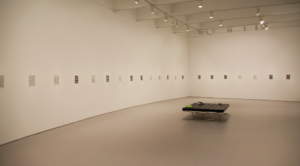
Tony Lewis’ “Anthology 2014-2016,” an installation composed of 34 poems mounted on the walls of the second floor of the Hirshhorn Museum and Sculpture Garden, explores the fragility of time and a longing to discern life’s meaning.
In addition to the artistic display, a booklet located in the middle of the room contains the typed poems and an introduction by Lewis explaining the gradual need he felt to type the poems as he completed the art pieces.
Among the themes in the poems are love, fear, action, desire and determination. Lewis is a young Chicago-based artist and the recipient of the 2017–2018 Ruth Ann and Nathan Perlmutter Artist-in-Residence Award at the Rose Art Museum at Brandeis University.
His monochromatic poems are made up of rearranged texts from his favorite comic strips: Calvin and Hobbes cartoons.
Lewis uses correction tape and graphite to block out certain words and phrases from the cartoons, which are then transformed into collage poems. Requiring purposeful construction and decision-making, this form of poetry — like blackout poetry and erasure — gives new meanings and suggestions to the underlying text, transcending the limitations and restrictions of traditional poetry and grammar.
At first glance, the exhibit seems somewhat distant and confusing. The words appear jumbled and arbitrarily chosen. However, as the reader proceeds from one poem to the next, it becomes clear the artist has purposefully selected these disjointed words.
Lewis, through the narrative and order of the poems, seems to shows the artistic procedure he undergoes while creating the poems. Just as he breaks apart and reorders certain phrases and sentences to create new ones, readers, too, piece the poems together themselves.
Lewis’ work offers a refreshing way to look at comic strips, which can be viewed as trivial or childish. The display looks back on childhood with nostalgia and longing.
The poems are sprinkled with emotionally charged words that add an ironic tang to the display, changing the originally humorous tone of the cartoons. Confronted with the choppy poems, viewers wonder what is hidden under the piled strips of correction tape.
The structure of the poems mirrors the thought processes the viewer may experience when engaging with certain pieces of art. The seemingly random speech bubbles mimic the thoughts that may randomly pop into the reader’s mind when reading the displayed poems.
Additionally, the exhibit emphasizes discovery and learning, which are most present in a child’s imagination. The poems reveal what it is like to observe the world in a carefree and fluid manner. The use of correction tape implies the presence of error and mistake — things only perceived as one ages.
Thus, the poems suggest that as we age, we feel the need to black out certain memories. At the same time, however, the clear delineation of each piece of correction tape demonstrates the near impossibility of this act.
Speaking about “Anthology: 2014-2016” in an interview with the Hirshhorn, Lewis said he sought to give new meaning to the beloved “Calvin and Hobbes” comics of the ’90s.
“This is the clearest form of writing I’ve done to date, transferring authorship from Bill Watterson’s dialogue to a distinct writing process,” Lewis said. “‘Calvin and Hobbes’ was a literary and artistic savior growing up in the ’90s. By physically destroying it, appropriating it, editing it and rebuilding its narrative, I find new language and ideas that culminate with an intimate collection of poems.”
While at first it can be difficult to discern exactly what Lewis wants the museum-goers to grasp when observing his art, the ambiguity reflects the purpose of both Lewis’s exhibit and art as a whole — to intrigue, captivate and confuse. Through delicate construction, Lewis gives new meaning to old comics and encourages the viewer to find their own meanings as well.
“Anthology: 2014-2016” is on display from March 6 through May 28 at the Hirshhorn Museum and Sculpture Garden. Admission to the museum is free and it is open daily from 10 a.m. to 5:30 p.m. The museum is located at Independence Avenue SW and 7th Street SW.



















